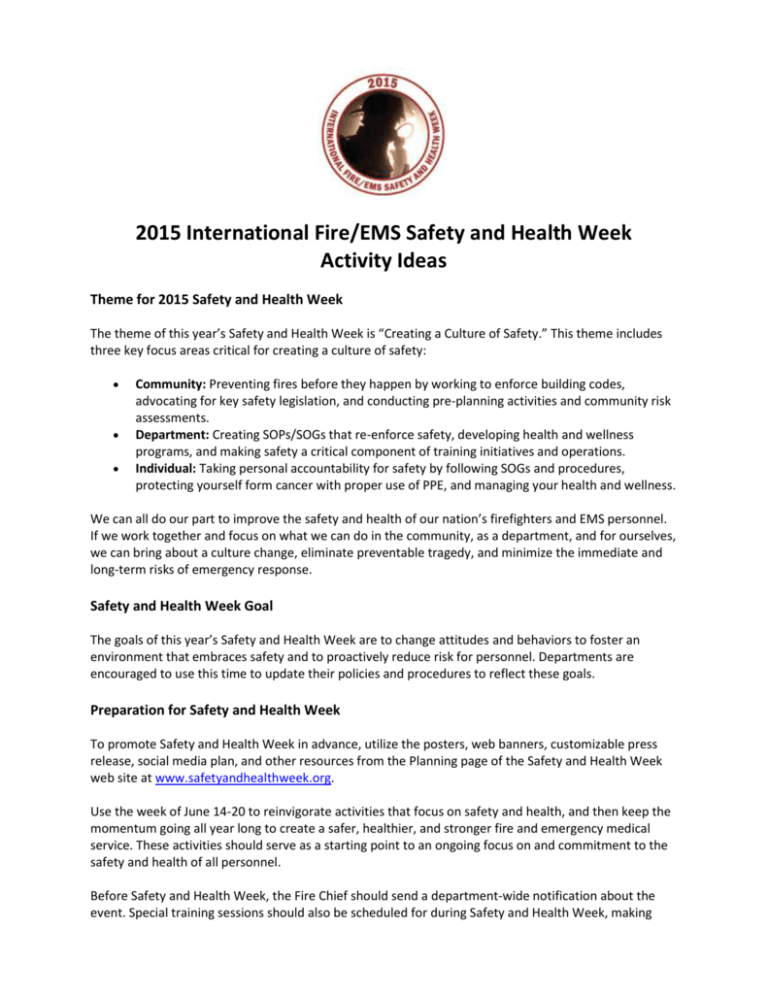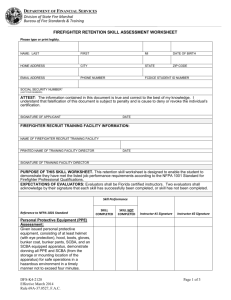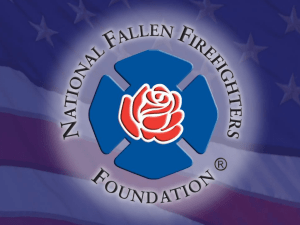2015-SHWeek-Activity..
advertisement

2015 International Fire/EMS Safety and Health Week Activity Ideas Theme for 2015 Safety and Health Week The theme of this year’s Safety and Health Week is “Creating a Culture of Safety.” This theme includes three key focus areas critical for creating a culture of safety: Community: Preventing fires before they happen by working to enforce building codes, advocating for key safety legislation, and conducting pre-planning activities and community risk assessments. Department: Creating SOPs/SOGs that re-enforce safety, developing health and wellness programs, and making safety a critical component of training initiatives and operations. Individual: Taking personal accountability for safety by following SOGs and procedures, protecting yourself form cancer with proper use of PPE, and managing your health and wellness. We can all do our part to improve the safety and health of our nation’s firefighters and EMS personnel. If we work together and focus on what we can do in the community, as a department, and for ourselves, we can bring about a culture change, eliminate preventable tragedy, and minimize the immediate and long-term risks of emergency response. Safety and Health Week Goal The goals of this year’s Safety and Health Week are to change attitudes and behaviors to foster an environment that embraces safety and to proactively reduce risk for personnel. Departments are encouraged to use this time to update their policies and procedures to reflect these goals. Preparation for Safety and Health Week To promote Safety and Health Week in advance, utilize the posters, web banners, customizable press release, social media plan, and other resources from the Planning page of the Safety and Health Week web site at www.safetyandhealthweek.org. Use the week of June 14-20 to reinvigorate activities that focus on safety and health, and then keep the momentum going all year long to create a safer, healthier, and stronger fire and emergency medical service. These activities should serve as a starting point to an ongoing focus on and commitment to the safety and health of all personnel. Before Safety and Health Week, the Fire Chief should send a department-wide notification about the event. Special training sessions should also be scheduled for during Safety and Health Week, making sure sessions are available to reach all duty shifts. The Fire Chief should send out a reminder notice a week prior to the event with any materials necessary to conduct training. Resources and Tools The Safety and Health Week web site (www.safetyandhealthweek.org) contains resources that are available to help the fire service implement a culture of safety in the community, the department, and for the individual. It also contains planning materials to help you get ready for the week and promote your department’s initiatives. In addition, check back for information on special Safety and Health Week events, including live webinars, the Safety and Health Week Quiz, and a fitness challenge. Activity Ideas Consider the following activity ideas to help you implement Safety and Health Week in your department. - Read the International Association of Fire Chiefs and U.S. Fire Administration’s report National Safety Culture Change Initiative to learn about the need for a culture change in the fire service and what organizational leadership as well as individuals can do to create this change and enhance the safety and health of first responders. - Look at what your department can do to implement the National Fallen Firefighters Foundation’s Firefighter Life Safety Initiatives, with a particular focus during Safety and Health Week on Initiative #1, Cultural Change and Initiative #15, Code Enforcement & Sprinklers. Find resources for all of the Firefighter Life Safety Initiatives at http://www.lifesafetyinitiatives.com/. o Resource Spotlight: Visit the National Fallen Firefighters Foundation’s Everyone Goes Home web site at http://www.everyonegoeshome.com to access additional Firefighter Life Safety resources and training that you can implement in your department. - Conduct a vulnerability assessment for your department to identify, quantify, and prioritize the vulnerabilities within your organization and what you can do to minimize the existing risks and increase the safety of your personnel. o Resource Spotlight: The Vulnerability Assessment Program is an online risk assessment tool developed by the National Fallen Firefighters Foundation with support from the U.S. Fire Administration and Honeywell that can be used by fire department leaders to identify existing risks within their organization that could lead to a firefighter injury or fatality and recommend low- or no-cost solutions to reduce or eliminate the risks. - Conduct a Community Risk Assessment in your community to identify the fire and life safety risks, prioritize those risks, determine how to prevent or mitigate risks, and actions personnel can take to reduce risks and educate the community on risk reduction strategies. o Resource Spotlight: Vision 20/20 provides guides, training, tools, and other materials to help departments with Community Risk Reduction and fire prevention advocacy. Additional resources can be found on the Safety and Health Week web site. - Provide advocacy resources and talking points to help your personnel promote residential fire sprinklers in the community and with legislators. o Resource Spotlight: The guide Residential Fire Sprinklers: A Step-by-Step Approach for Communities, provided by the International Association of Fire Chiefs and the National Fire Sprinkler Association, is designed to help stakeholders support the process of developing, adopting, and defending a residential fire sprinkler program in their community. The 2015 Safety and Health Week Activity Ideas Page 2 National Fire Protection Association’s Fire Sprinkler Initiative provides resources to help individuals advocate for residential sprinklers. - Work with your local building or code official to host a training session at your department that informs personnel how they can work with these officials to enhance community safety and enforce safety codes. o Resource Spotlight: The guide Understanding and Implementing the International Fire Code, developed by the National Volunteer Fire Council and the International Code Council, helps fire service personnel gain a basic understanding of how to use a model fire safety code to ensure an acceptable level of safety for both the public and firefighters. A companion training webinar is also available in the NVFC Virtual Classroom. - Evaluate and update your department’s policies and procedures to make sure they are current and adhere to the strictest safety measures. Distribute a copy to every member of your department and schedule a personnel training session to go over the policies/procedures, stress the importance of adhering to safety procedures, and make sure everyone understands what is expected of them. - Review NFPA Standards that relate to health and wellness programs, medical evaluations, and proper use and maintenance of PPE and develop an action plan for how your department can meet these standards if you find any lapses. All NFPA codes and standards can be viewed for free at www.nfpa.org/freeaccess. o Resource Spotlight: The National Volunteer Fire Council and National Fire Protection Association developed two guides for Understanding and Implementing Standards, with a focus on NFPA 1500, 1720, 1851, 1407, and 1021. The International Association of Fire Chiefs developed the Fire Department’s’ Guide to Implementing NFPA 1582. - Utilize the International Association of Fire Chief’s Rules of Engagement for Structural Firefighting lesson plan to train your personnel on the Rules of Engagement for Firefighter Survival and the Incident Commander’s Rules of Engagement for Firefighter Safety. - Distribute a copy of the National Volunteer Fire Council’s B.E.S.T. Priorities for Firefighter Health and Safety to all personnel and hang a copy of the poster up at the department as a constant reminder of the best practices all responders should adhere to in regards to Behavior, Equipment, Standards and Codes, and Training. - Hold an educational session to review training ground safety. Enforce good response habits in all trainings so that personnel are prepared when they go to the scene. Emphasize the importance of proper and full use of PPE at all times on the emergency scene, as well as during training exercises that simulate emergency scenes. Safe habits practiced during training will translate to safe habits on-scene. In addition, harmful contaminants can be present during live training exercises, so a safe training ground includes proper use of PPE. - Read the Firefighter Cancer Support Network’s white paper Taking Action Against Cancer in the Fire Service. Distribute the 11 action items listed on the page “What Immediate Actions Can I Take to Protect Myself” to all department members. Make sure these action items are incorporated in trainings to prepare personnel for response, and then enforced on and after the emergency scene. - Review the maintenance schedule for all of your department’s PPE and make sure your department is following manufacturer guidelines. Develop a plan for replacing PPE as required based on 2015 Safety and Health Week Activity Ideas Page 3 manufacturer guidelines and safety standards. Hold a training session or drill with all personnel to review proper maintenance, use, and storage procedures for PPE. o Resource Spotlight: The National Volunteer Fire Council offers an equipment management template, equipment management webinar series, and PPE quick tips video series that covers funding, replacing, cleaning, storing, and regulatory standards for PPE. The National Fire Protection Association’s Standard 1851 establishes requirements for the selection, care, and maintenance of structural firefighting protective ensembles to reduce health and safety risks associated with improper maintenance, contamination, or damage (access the Standard for free at www.nfpa.org/ free-access). The Firefighter Cancer Support Network’s white paper Taking Action Against Cancer in the Fire Service discusses why proper use, maintenance, and cleaning of PPE is so critical in protecting firefighters from cancer. - Ask department members to take available online training courses that focus on various elements of safety, health, and risk reduction. o Resource Spotlight: Find online courses from the National Volunteer Fire Council, the International Association of Fire Chiefs, the National Fallen Firefighters Foundation, Fire Corps, Vision 20/20, IFSTA, the National Fire Protection Association, the U.S. Fire Administration, ResponderSafety, Firefighters Support Foundation, and Fire Engineering, among others. - Participate in the Safety and Health Week webinars taking place June 16 and 18 at 11am EDT. Information on topics and speakers will be available soon on the Planning Page of the Safety and Health Week web site. - Leading up to Safety and Health Week, challenge your members to take the 2015 Safety and Health Week Quiz, brought to you by the National Fire Protection Association, National Volunteer Fire Council, and International Association of Fire Chiefs. The quiz will test individuals’ knowledge of key fire and emergency service safety and health facts. 200 randomly selected quiz takers will receive a 2015 Safety and Health Week Challenge Coin. Information on the quiz will be available on the Planning Page of the Safety and Health Week web site starting in early May. - Fighting fires and responding to emergencies is a physically demanding job. Being physically ready for the job at hand can help reduce risk factors for heart disease, diabetes, and other potentially lifethreatening conditions. Make sure you and your department members are physically fit and ready to answer the call by developing a health and fitness plan. Educate members on the importance of proper fitness and nutrition, and implement an ongoing health and fitness program in your department. Incorporate functional fitness into department training, and encourage members to make simple lifestyle changes that can improve their abilities to safely and effectively respond to emergencies. o Resource Spotlight: The NVFC’s Heart-Healthy Firefighter Program has resources for implementing a department health and wellness program as well as to help individuals take steps to improve their health and wellness. A recent interview with Dan Kerrigan from the East Whiteland Fire Department provides a Q&A on how one department was able to successfully incorporate health and fitness into the culture of the organization and make health and wellness a priority. - Coordinate a fitness challenge in your department or between multiple departments in your area to encourage personnel to focus on fitness and heart health. A national fitness challenge will be held in conjunction with Safety and Health Week that will help provide motivational tools and challenge 2015 Safety and Health Week Activity Ideas Page 4 resources your department can utilize. Information will be available soon on the Planning Page of the Safety and Health Week web site. - Behavioral health is just as important as physical health and safety. Unchecked behavioral health issues can lead to distracted behavior or carelessness on-scene, physical health issues, broken relationships, and even suicide. Educate yourself and your personnel on behavioral health issues to prevent future tragedies. Set up an in-person training session to discuss important behavioral health concerns such as stress, depression, PTSD, and addiction, teach personnel warning signs/ symptoms and what to do if they identify a fellow responder in trouble, provide a list of resources available for those who need help, and review department policies and procedures concerning behavioral health. o Resource Spotlight: The National Volunteer Fire Council offers the Fire/EMS Helpline, behavioral health resource listing, online training for behavioral health, Warning Signs to Know video, and other resources through the Share the Load Program. 2015 Safety and Health Week Activity Ideas Page 5





